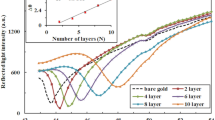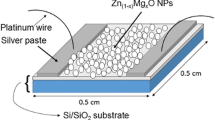Abstract
The nanostructured β-Bi2O3 thin film was deposited on glass substrates by chemical spray pyrolysis technique using the mixture of bismuth nitrate pentahydrate with deionized water and nitric acid as a precursor solution. The thin film deposition condition and the precursor salt concentration were optimized to obtain nanostructured β-Bi2O3 thin films. The film obtained from 0.05 M of bismuth nitrate pentahydrate aqueous solution was sprayed at the rate of 3 mL/min. on pre-heated glass substrate at the temperature of 250 °C yielded spherical shaped well-connected nanocrystallites, which has large surface area. The diffraction peak position in XRD confirmed the formation of crystalline β-Bi2O3 with tetragonal crystal structure. Further sensing characteristics of β-Bi2O3 thin film towards various dimethylamine (DMA) vapour concentration have been investigated. The sensing results revealed that β-Bi2O3 thin film shows good sensing response towards dimethylamine vapour at an ambient temperature. The minimum detection limit was found to be 0.5 ppm, and sensors show shorter response and recovery time (28 s and 10 s). The dimethylamine sensing characteristics (response, sensitivity, electrical hysteresis, selectivity in mixed vapour environment, stability) of β-Bi2O3 thin films were discussed and reported.














Similar content being viewed by others
References
Zhang, L., Zhao, J., Lu, H., Li, L., Zheng, J., Zhang, J., Li, H., & Zhu, Z. (2012). Highly sensitive and selective dimethylamine sensors based on hierarchical ZnO architectures composed of nanorods and nanosheet-assembled microspheres. Sensors and Actuators B : Chemical, 71–172, 1101–1109.
Yu, C., Liu, G., Zuo, B., & Tang, R. (2009). A novel gaseous dimethylamine sensor utilizing cataluminescence on zirconia nanoparticles. Luminescence, 24, 282–289.
OSHA< https://www.osha.gov/dts/chemicalsampling/data/CH_235700.html>
Martínez, Y. M., Falcó, P. C., & Hernández, R. H. (2004). A method for the determination of dimethylamine in air by collection on solid support sorbent with subsequent derivatization and spectrophotometric analysis. Journal of Chromatography A, 1059, 17–24.
Teerlink, T., Hennekes, M. W. T., Mulder, C., & Brulez, H. F. H. (1997). Determination of dimethylamine in biological samples by high performance liquid chromatography. Journal of Chromatography B, 691, 269–276.
Pericas, C. C., Hernandez, R. H., & Falco, P. C. (2005). A new selective method for dimethylamine in water analysis by liquid chromatography using solid-phase microextraction and two-stage derivatization with o-phthalaldialdehyde and 9-fluorenylmethyl chloroformate. Talanta, 66, 1139–1145.
Tsikas, D., Thum, T., Becker, T., Pham, V. V., Chobanyan, K., Mitschke, A., Beckmann, B., Gutzki, F. M., Bauersachs, J., & Stichtenoth, D. O. (2007). Accurate quantification of dimethylamine (DMA) in human urine by gas chromatography–mass spectrometry as pentafluorobenzamide derivative: Evaluation of the relationship between DMA and its precursor asymmetric dimethylarginine (ADMA) in health and disease. Journal of Chromatography B, 851, 229–239.
Zlotorzynska, E. D., & Maruszak, W. (1998). Determination of dimethylamine and other low-molecular-mass amines using capillary electrophoresis with laser-induced fluorescence detection. Journal of Chromatography B, 714, 77–85.
Timm, M., & Jørgensen, B. M. (2002). Simultaneous determination of ammonia, dimethylamine, trimethylamin e and trimethylamine- n-oxide in fish extracts by capillary electrophoresis with indirect UV-detection. Food Chemistry, 76, 509–518.
Roy, S., & Basu, S. (2004). ZnO thin film sensors for detecting dimethyl- and trimethyl-amine vapors. Journal of Material Science: Materials in Electronics, 15, 321–326.
Takao, Y., Nakanishi, M., Kawaguchi, T., Shimizu, Y., & Egashira, M. (1995). Semiconductor dimethylamine gas sensors with high sensitivity and selectivity. Sensors and Actuators B: Chemical, 24–25, 375–379.
Gujara, T. P., Shindea, V. R., Lokhandea, C. D., Maneb, R. S., & Han, S. H. (2005). Bismuth oxide thin films prepared by chemical bath deposition (CBD) method: Annealing effect. Applied Surface Science, 250, 161–167.
Soitah, T. N., Chunhui, Y., Yong, Y., Yinghua, N., & Liang, S. (2010). Properties of Bi2O3 thin films prepared via a modified Pechini route. Current Applied Physics, 10, 1372–1377.
Leontie, L., Caraman, M., Alexe, M., & Harnagea, C. (2002). Structural and optical characteristics of bismuth oxide thin films. Surface Science, 507–510, 480–485.
Bandoli, G., Barreca, D., Brescacin, E., Rizzi, G. A., & Tondello, E. (1996). Pure and mixed phase Bi2O3 thin films obtained by metal organic chemical vapor deposition. Chemical Vapour Deposition, 2, 238–242.
Thomas, M. (2013). Review of Bi2O3-based glasses for electronics and related applications. International Materials Reviews, Maney Publishing, 58, 3–40.
Gou, X., Li, R., Wang, G., Chen, Z., & Wexler, D. (2009). Room temperature solution synthesis of Bi2O3 nanowires for gas sensing application. Nanotechnology, 20, 495–501.
Ali, R. S. (2014). Structural and optical properties of nanostructured bismuth oxide. International Letters of Chemistry, Physics and Astronomy, 34, 64–72.
Sammes, N. M., Tompsett, G. A., NaÈfea, H., & Aldinger, F. (1999). Bismuth based oxide electrolytes-structure and ionic conductivity. Journal of European Ceramic Society, 19, 1801–1826.
Morasch, J., Lil, S., Brötz, J., Jaegermann, W., & Klein, A. (2014). Reactively magnetron sputtered Bi2O3 thin films: Analysis of structure, optoelectronic, interface, and photovoltaic properties. Physica Status Solidi, A, 211, 93–100.
Park, S., Jun, J., Kim, H. W., & Lee, C. (2009). Preparation of one dimensional Bi2O3-core/ZnO-shell structures by thermal evaporation and atomic layer deposition. Solid State Communication, 149, 315–318.
Weidong, H., Wei, Q., Xiaohong, W., Xianbo, D., Long, C., & Zhaohua, J. (2007). The photocatalytic properties of bismuth oxide films prepared through the sol–gel method. Thin Solid Films, 515, 5362–5365.
Mota, K. B., Bizarro, M., Castellino, M., Tagliaferro, A., Hernándezd, A., & Rodil, S. E. (2015). Spray deposited β-Bi2O3 nanostructured films with visible photocatalytic activity for solar water treatment. Photochemical and Photo Biological Sciences, 14, 1110–1119.
Jeyaprakash, B. G., Kesavan, K., Ashok Kumar, R., Mohan, S., & Amalaran, A. (2011). Temperature dependent grain-size and microstrain of CdO thin films prepared by spray pyrolysis method. Bulletin of Material Science, 34, 601–605.
Pandeeswari, R., & Jeyaprakash, B. G. (2014). High sensing response of β-Ga2O3 thin film towards ammonia vapours: Influencing factors at room temperature. Sensors and Actuators B: Chemical, 195, 206–214.
Eneşca, A., & Duţă, A. (2010). The influence of the precursor concentration on the properties of SnO2 thin films. Thin Solid Films, 519, 568–572.
Denisov, V. N., Ivlev, A. N., Lipin, A. S., Mavrin, B. N., & Rlov, V. G. (1997). Raman spectra and lattice dynamics of single-crystal α-Bi2O3. Journal of Physics: Condensed Matter, 9, 4967–4978.
Cabot, A., Marsal, A., Arbiol, J., & Morante, J. R. (2004). Bi2O3 as a selective sensing material for NO detection. Sensors and Actuators B: Chemical, 99, 74–89.
Prekajski, M., Kremenović, A., Babić, B., Rosić, M., Matović, B., Mihajlović, A. R., & Radović, M. (2010). Room-temperature synthesis of nanometric α-Bi2O3. Material Letters, 64, 2247–2250.
Yang, L. L., Han, Q. F., Zhao, J., Zhu, J. W., Wang, X., & Ma, W. H. (2014). Synthesis of Bi2O3 architectures in DMF–H2O solution by precipitation method and their photocatalytic activity. Journal of Alloys and Compounds, 614, 353–359.
Barsan, N., & Weimar, U. (2001). Conduction model of metal oxide gas sensors. Journal of Electroceramics, 7, 143–167.
Nie, M. (2008). Organic chemistry. Metallurgical Industry Press.
Cao, X., Song, T., & Wang, X. (1994). Inorganic Chemistry (3rd ed.). Higher Education Press.
Roy, S., & Basu, S. (2004). ZnO thin film sensors for detecting dimethyl- and trimethylamine vapours. Journal of Material Science: Materials in Electronics, 15, 321–326.
Jamalabadi, H., Varnosfaderani, A. M., & Alizadeh, N. (2017). PPy-Metal oxide hybrid nanocomposite sensor array for simultaneous determination of volatile organic amines in high humid atmosphere. IEEE Sensor Journal, 17, 8282–8289.
Sovizi, M., & Somayeh Mirzakhani, R. (2020). A chemiresistor sensor modified with lanthanum oxide nanoparticles as a highly sensitive and selective sensor for dimethylamine at room temperature. New Journal Chemistry, 44, 4927–4934.
Srividhya, G., Abinaya, M., Veena, M., Veeraprabu, K., & Sridharan, M. (2020). Highly selective dimethylamine sensing performance of TiO2 thin films at room temperature. Journal of Nanoscience and Nanotechnology, 20, 3133–3139.
Vardan, G., Ponzoni, A., Kholmanovc, I., Natile, M. M., Comini, E., & Sberveglieri, G. (2020). Highly sensitive and selective detection of dimethylamine through Nb doping of TiO2 nanotubes for potential use in seafood quality control. Sensors and Actuators: B Chemical, 303, 127217.
Author information
Authors and Affiliations
Corresponding author
Ethics declarations
Conflict of interest
This author declares no conflict of interest, financial or otherwise.
Additional information
Publisher's Note
Springer Nature remains neutral with regard to jurisdictional claims in published maps and institutional affiliations.
Rights and permissions
About this article
Cite this article
Pandeeswari, R., Sonia, T., Balamurugan, D. et al. Highly Selective Dimethylamine Vapour Sensors Based on Spray Deposited β-Bi2O3 Nanospheres at Low Temperature. Sens Imaging 23, 1 (2022). https://doi.org/10.1007/s11220-021-00371-1
Received:
Revised:
Accepted:
Published:
DOI: https://doi.org/10.1007/s11220-021-00371-1




